A couple of years back, I happened to travel in a cab whose driver was very chatty and unusually boastful of his knowledge of the city. About 20 minutes into the journey, I had enough of his tales and asked him:
“Since you know so much about Mumbai, tell me how does one get to Sewri Fort. I want to visit it.”
“Sewri Fort? What Sewri Fort? There is no Fort at Sewri.”
“Of course, there is a fort there. I read a report about the Fort in the newspaper only last week.”
“Newspaper? Bah !” said the driver in a dismissive tone. “Don’t believe everything that they print. Listen to me, I’ve been there so many times that I know the area really well. I know Sewri Jetty, all the automobile service centres there, the Port Trust Offices, the dargah… everything. I can tell you confidently that I have never come across any Fort there.”
And that was the end of the conversation.
Last month, I visited Sewri Fort. Yes, there is a Fort, but after visiting it I could understand why the cab driver and many others like him are neither aware of its location or existence. Incidentally, it is located right next to the dargah that the driver mentioned. Just see the view outside the Fort in the photograph below. Is there any indication that there is a Fort anywhere in the vicinity?

The structure behind the white shed is the Fort and there are no signboards to indicate that this is the Sewri Fort. It also doesn’t help that the Fort doesn’t look like one. By looks, I mean there are no discernible ramparts or fortifications to be seen. In fact, if Anuradha, a fellow blogger who had visited the Fort earlier, had not been with me and showed the way, I’m pretty sure I would not have been to find it.

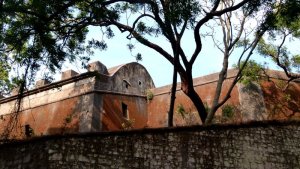 Once I’d gotten past the surprise of the rather nondescript entrance to Sewri Fort, I was all set to explore it. But first, let me share a little bit of the history of the Fort, which is one of Mumbai’s 8 existing Forts.
Once I’d gotten past the surprise of the rather nondescript entrance to Sewri Fort, I was all set to explore it. But first, let me share a little bit of the history of the Fort, which is one of Mumbai’s 8 existing Forts.
According to the information available online, the Sewri Fort was built by the British in 1680, and was one of the 3 forts constructed by them on the eastern shoreline, the other two being Sion Fort and Mazgaon Fort. It is built on a high hill from rocks quarried from its hillside and is surrounded by land on 3 sides; the 4th side is a sheer cliff that drops down into the mangroves.
Built for security purposes, the Sewri Fort served as a watchtower and was also the first line of defence in the case of attacks and invasions from the
Angrias of Alibaug, the Siddis of Habsan, pirates from Janjira, the Savant from Wadi and the Dhulap from Vijaydurg.
The above extract is from Govind Narayan’s Mumbai: An Urban Biography from 1863, which also gives a rather vivid attack on Mumbai on February 22, 1689, when
the Siddi of Habsan, Yakut Khan arrived with a force of 20,000, landed at Sewri and commandeered the Sewri Fort… the Siddi army… attacked the fort at Mazgoan the following day and drove away the sentries. All the guns, gunpowder and ten boxes of money fell into their hands… Yakut Khan stayed in Mumbai for over a year and left on 8 June 1690 after burning down the fort at Mazgaon.
The British must have learnt from the invasion of Yakut Khan, for when the Portuguese attacked Sewri Fort in 1772, their defences held. As threats from the sea abated, the importance of the Sewri Fort too waned and it got converted into a godown of the Mumbai Port Trust. Not surprisingly, it was in a pretty bad shape when the Maharashtra State’s Department of Archaeology and Museums took over its upkeep and renovation a few years back and classified it as a Grade I structure.

 It’s only when you enter the Fort through the main entrance that you realise that there is an inner structure as well and the entrance to the inner portions is set at right angles to the main entrance — a common defense mechanism seen in forts.
It’s only when you enter the Fort through the main entrance that you realise that there is an inner structure as well and the entrance to the inner portions is set at right angles to the main entrance — a common defense mechanism seen in forts.
One then has to pass through a dark room full of modern-day graffiti before emerging into a courtyard-like space with a lone tree at one end. On one side are domed structures, which could have been guard rooms or storage for arms and ammunition or both. On the other side is a roofless room with windows that look out onto the seaward side of the Fort.
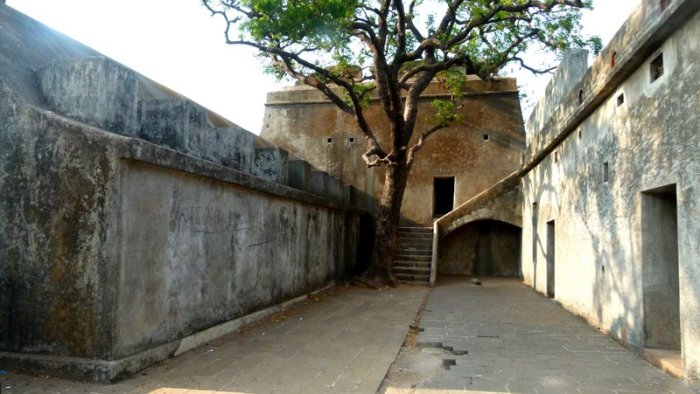

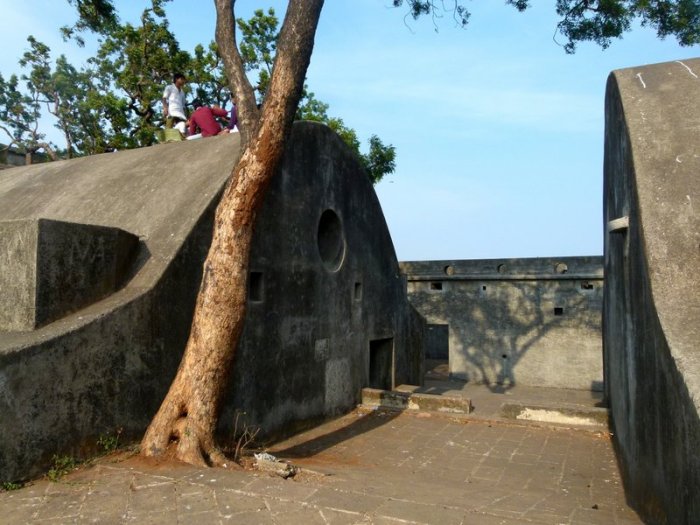
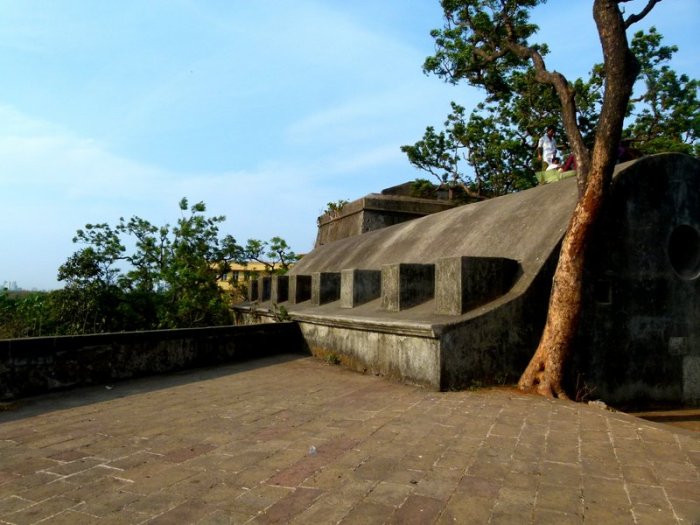
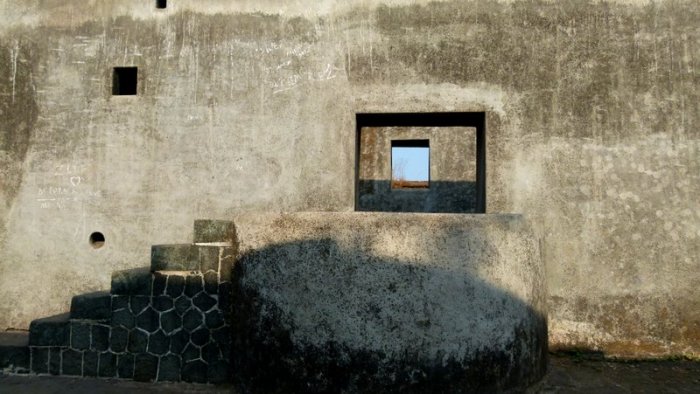 The views from the Sewri Fort are varied — depending on the direction it varies from highrises to industrial units to the Sewri Jetty to the dargah next door to flamingos (you can read more about that and my excitement on seeing them here).
The views from the Sewri Fort are varied — depending on the direction it varies from highrises to industrial units to the Sewri Jetty to the dargah next door to flamingos (you can read more about that and my excitement on seeing them here).


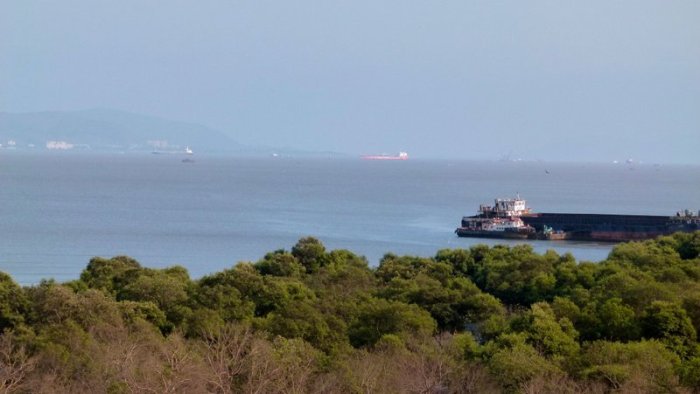
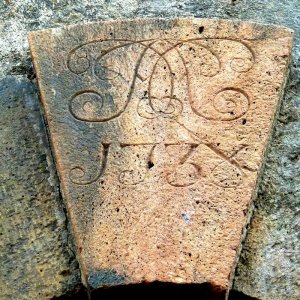 I found the Sewri Fort very interesting in many aspects — it strategic location, its size, its architecture, and of course its history or rather lack of. Whatever little information I could find on the internet mention that the Fort was built in 1680 by the British. Somehow, I’m not too sure about this due to two reasons: (i) the design is not British, and (ii) this stone (see photo on the right) which is placed over the entrance to the Fort’s courtyard.
I found the Sewri Fort very interesting in many aspects — it strategic location, its size, its architecture, and of course its history or rather lack of. Whatever little information I could find on the internet mention that the Fort was built in 1680 by the British. Somehow, I’m not too sure about this due to two reasons: (i) the design is not British, and (ii) this stone (see photo on the right) which is placed over the entrance to the Fort’s courtyard.
I’m not sure what this inscription says though some fellow bloggers have interpreted it to read 1734 or 1736. The only thing I’m sure of is that it does not read 1680, the date when the Fort is supposed to have been built. My theory is that there was an older structure present here, perhaps built by the Portuguese, which was rebuilt by the British only in the 18th century and this date stone represents that.
Coming back to the design of the Fort, in spite of the kilos of concrete poured over the original structure in the name of renovation or restoration, the design has thankfully not been interfered with. The curved roof of the guard room/ammunition store looks more Portuguese and less British to me. Just saying.
 But the most interesting aspect of the Sewri Fort is the variety of building stones used — dark greyish black basalt, yellowish pink rhyolite, to a dark green rock that I couldn’t identify — which makes me think that the interiors of the Fort were polychromatic and there was a certain aesthetic sense involved in building it. The outer walls of the Fort would have been the same colour as that of the hillock on which it was based to blend in with the landscape. In fact, when we tried to locate the Fort from the Sewri Jetty we couldn’t see it, though the Jetty was clearly visible from the Fort (see the 13th photo in this post).
But the most interesting aspect of the Sewri Fort is the variety of building stones used — dark greyish black basalt, yellowish pink rhyolite, to a dark green rock that I couldn’t identify — which makes me think that the interiors of the Fort were polychromatic and there was a certain aesthetic sense involved in building it. The outer walls of the Fort would have been the same colour as that of the hillock on which it was based to blend in with the landscape. In fact, when we tried to locate the Fort from the Sewri Jetty we couldn’t see it, though the Jetty was clearly visible from the Fort (see the 13th photo in this post).
 We spent a pleasant evening at the Fort before making our way to the Sewri Jetty to see the flamingos. Like the Sion Fort, the Sewri Fort too had quite a few young men just hanging around the place. They were quite curious about what we (a group of 3 women and a child) were up to and apart from asking us to take their photographs, didn’t bother us. But still, I was thankful for the company I had and was happy that I wasn’t alone. 🙂
We spent a pleasant evening at the Fort before making our way to the Sewri Jetty to see the flamingos. Like the Sion Fort, the Sewri Fort too had quite a few young men just hanging around the place. They were quite curious about what we (a group of 3 women and a child) were up to and apart from asking us to take their photographs, didn’t bother us. But still, I was thankful for the company I had and was happy that I wasn’t alone. 🙂
The Sewri Fort has been the most fascinating of the forts I have visited and it’s vantage point on the eastern shoreline makes it all the more so.The complete lack of signboards or information boards though was quite a frustrating experience, and I always wonder why it has to be so.
Last week, I read a newspaper report that said that the Maharashtra Tourism Department Corporation (MTDC) has plans of reviving the Sewri Fort and proposed a “makeover of the fort to include a museum, mini-theatre, souvenir shop and an open deck restaurant”.
Dear MTDC, what about basic things like cleaning up the surroundings and the Fort itself, posting signboards and information boards, and having security guards in place? While I agree that the Sewri Fort needs to be revived and that much needs to be done, an open air deck restaurant is not one of them. Have you considered the fact that the restaurant will only threaten the already dying mangroves in the area and, in turn, drive away the migratory birds that you claim people can watch from the deck?
You don’t need to ‘prettify’ and ‘fancify’ Sewri Fort. Just get the basics in place and people will come.
=====
Read about the other Forts of Mumbai

Great discovery, Sudha. I have been curious about the forts in Mumbai myself, specially after I was pleasantly surprised by the Bandra fort! Haven’t been to any other in the city, but each one I visited in Sahayadris has been as spectacular and intriguing as the other.
LikeLike
Welcome to the blog, Smriti, and thank you so much for stopping by and commenting. 🙂
In all fairness, I didn’t discover it. I got to know of the fort after I read about it in the newspaper and then saw posts of a couple of my fellow bloggers.
The Bandra Fort is the most popular by virtue of its location by the sea and of course Bandra itself. I think that Maharashtra has the most number of forts in India, and each one of them is, as you have rightly said, “as spectacular and intriguing as the other”.
Do keep visiting 🙂
LikeLike
When we see or hear about a fort in the unlikeliest places, the first question that comes to the mind is: why have a fort here? What purpose did it serve then? It takes dogged research to come up with a plausible explanation and even more doggedness to explain to an uninterested and unaware public. I think it is time to teach history by beginning with a walk around the neighbourhood and widen the view. Hopefully, then, we can expect a more knowledgeable and sensitive generation. BTW, when I visited it, I felt the same way about the Bellary fort. The locals weren’t more helpful beyond a ‘oh that’ and pointing in its direction. It took some study of Hyder Ali’s rule to understand why it was so important then. If you hadn’t known, it would have merely appeared to be an exercise in self-indulgence. Today’s Mumbaikars identify Sewri with Trucks and Truckers and rundown warehouses. Good post
LikeLike
Thanks, Srinayan. In the case of Sewri Fort, it is clear that it was built for security purpose and was the only site at a height. What is not clear is when it was built, who built it, why was the particular design chosen… etc.
Thanks to the publicity with regard to flamingos, Mumbaikars also know it for the birds, but very few people know about the Fort. BTW, Sewri is also home to the service centres of many international car brands.
LikeLike
Worth the wait, Sudha! Enjoyed reading it, and reliving the wonderful time we spent there. As I write this comment, samhith is looking over my shoulder and laughing at the vagaries of auto correct, which is apt, considering how he accompanied us and rushed us along there 🙂 and I really hope the mtdc guys read ur post and don’t mess up the place more than it already is!
LikeLike
The MTDC guys will probably see the post and dismiss me as another of those ‘heritage-loving’ people who have no clue what needs to be preserved and what needs to be marketed and how it should be marketed even 😛
Having said that I hope that this is one plan of the MTDC that stays stuck in red tape and bureaucracy and never sees the light of the day.
LikeLike
Wow! Each time I read your posts, my list of places to see increases. Thank you !
LikeLike
Thanks, Nirupama. I hope that you do visit at least some of those places and strike them off the list. 🙂
LikeLike
I knew about about sewri fort thru newspapers but dint know how to get there…whoaa it looks deserted..i really hope the MTDC revives these places…its a pity we havent done much to preserve the history…
LikeLike
A warm welcome to the blog, Divz, and thank you for stopping by and commenting. Sewri Fort is a 10-15 minute walk from Sewri station and unless you know where it is, you will not be able to find it. You can find it with the help of Google Maps though. MTDC should definitely revive the place, but not the way they have planned it.
LikeLike
I have seen two photographs of Sewri Fort uploaded by another blogger friend but its great to know about the wonderful history behind it..Hope that the government intervene not with monetary thoughts but with the thought of preserving it..thanks for sharing..
LikeLike
Welcome here, Ranita, and thank you so for for stopping by and commenting. I have seen 4 of Mumbai’s 8 posts and in my opinion is the most interesting fort. As for MTDC and government agencies, I can’t figure out why they think a hotel should be part of a Fort’s revival. Seriously, they have no idea of priorities.
LikeLike
How on earth do you manage to click such astounding pics…I am at awe…loved the write up and yes your little note to MTDC!
LikeLike
With a camera ! 😛
Thanks, RM.
LikeLike
Sudha, I love your blog, especially, the posts on Mumbai where you bring out such hidden/ignored aspects. There needs to be mass awareness about the heritage of Mumbai and I really appreciate your contribution towards that.
LikeLike
Dear Pradsword, thank you so much for your wonderful words and appreciation 🙂
LikeLike
wow its really amazing post. Thanks to share this all. I would like to visit Tourist places in Mumbai
LikeLike
wow!!
those were amazing pictures…
actually i’m too a photography enthusiast and i’d like to join you for a walk like this someday if you don’t have any problem..
LikeLike
Welcome to my blog, Apoorve, and thanks a lot for taking the time to share your appreciation in the comments section. Most of my Mumbai explorations are planned at very short notice. If I plan something in advance, will definitely let you know. Cheers 🙂
LikeLike
Your post was amazing and I decided to visit the fort. Me and my frnd had just entered it to see a group of guys playing cricket inside the open complex. We still decided to brave it and explore it when a guy came running form outside and told us girls are not allowed in this fort. We argued with him to no end and sadly walked away with without visiting the fort.
LikeLiked by 1 person
Hello Sanjana, welcome to my blog and thank you so much for stopping by and commenting.
I am so sorry that you had such an experiience. I can guess what would have happened – the watchman would have disappeared and the person who told you about ‘girls not being allowed inside the Fort’ would have come from the dargah next door. Unfortunately, this has been happening a lot these days. The Fort does not belong to the dargah, though the dargah seems to think that the fort is an extension of the dargah.
May I suggest that you visit the Sewri Fort with a large group organised by the BNHS or Breakfree Journeys?
LikeLike
I just discovered your informative blog. Thank you for the passion with which you write your posts. It has been a fascinating journey through Bombay’s forts.
The date on the inscription does look like 1734 and the 4 is written as half 8. I have seen 4 written that way quite often. In the European middle ages 4 was quite often written that way.
Check: https://de.wikipedia.org/wiki/Vier#/media/Datei:Zahl1497.jpg
But it is interesting to note that the direction of the open 8 is directed upwards in Sewri fort rather than downwards. 1734 was surely not middle ages anymore and in this baroque age, maybe the artists took some liberties. Or is it a case of misinterpretation by the local mason, who didn’t knew his way around the new numerals?
Thank you for making my brain spin a bit.
LikeLike